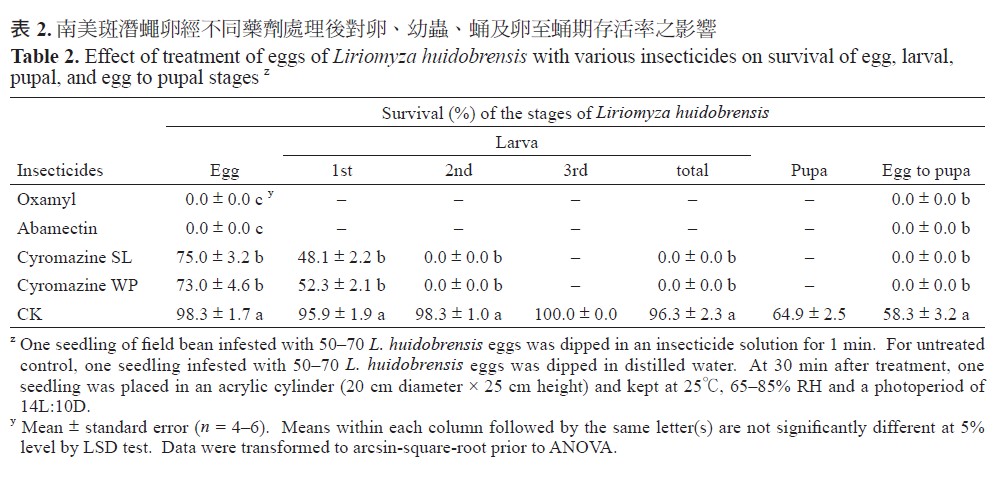All issues

Author:Ching-Chin Chien* and Shu-Chen Chang
Abstract:
Opius caricivorae Fischer is an important species of native parasitoid of leafminer Liriomyza huidobrensis (Blanchard) in Taiwan. In this study, seedlings of ?eld beans (Phaseolus vulgaris var. communis Aeschers) treated with insecticides (oxamyl SL, abamectin EC, cyromazine SL, or cyromazine WP) were used to determine effect of insecticides on survival and fertility of leafminer (L. huidobrensis) and its parasitoid (O. caricivorae) at different development stages under laboratory conditions. Results showed that all the insecticides (oxamyl, abamectin, cyromazine SL and cyromazine WP) had signi?cant (P < 0.05) lethal effects on L. huidobrensis and could be used in the control of leafminer. The highest lethal effect of oxamyl and abamectin was at the egg and larval stages with a survival rate of 0%, and the second most effective period was at the adult stage. When adult ?ies were treated with either oxamyl or abamectin for 24 hours, the female survival rate, male survival rate, number of eggs and number of feeding stipples decreased by 25.1–27.1, 38.8–40.5, 90.3–98.6 and 94.6–99.2%, respectively. The female longevity, male longevity, adult progeny and number of feeding stipples after treatment for 24 hours also decreased by 50.8–67.8, 59.8–71.7, 88.1–93.3 and 84.3–93.9%, respectively. The highest lethal effect of the two cyromazine formulations was at the larval stage with a survival rate of 0% and the second most effective period was at the adult stage. Treatment of adult ?ies with each of the two cyromazine formulations for 24 hours resulted in no signi?cant reduction in female survival rate, male survival rate, number of eggs, and feeding stipples. However, both formulations reduced female longevity, male longevity, adult progeny and number of feeding stipples after treatment for 24 hours by 26.0–26.6, 39.4–43.3, 85.1–89.6 and 83.9–86.2%, respectively. The two cyromazine formulations had least effect on the egg stage of L. huidobrensis with 23.7–25.7% reduction of egg hatching rate and larval mortality rate of 45.5–49.8% for the 1st instar and 100% for the 2nd instar. All the insecticides had no lethal effect on the egg stage of the parasitoid O. caricivora, but they were lethal on larval to pupal stages of this wasp with a survival rate of 0%. Abamectin was the most toxic insecticide on the wasp among the insecticides tested. When adult wasps were treated with insecticide for 24 hours, the survival rates of female and male decreased 90.0% and 46.7%, respectively, for the treatment of abamectin; the survival rate of female decreased 21.4% for the treatment of oxamyl. The percentage of hosts (L. huidobrensis) killed by the combined treatment of insecticide and wasps was 100%, compared to 64.8% killed by the treatment of wasps alone. After the adult wasps were treated with either abamectin or oxamyl, the number of eggs and progeny of adult wasps decreased by 67.7–86.2% and 100%, respectively, compared to the decrease of 0% in number of eggs and 100% of progeny of adult wasps by the treatment of cyromazine. When adult wasps were treated with each of the three insecticides for 24 hours and released on untreated bean seedlings infested with hosts (L. huidobrensis) daily, abamectin caused a reduction in longevity of female and male wasps by 80.7% and 59.0%, and fertility of wasps by 100%. However, no effect was observed on longevity, fertility, and female proportion of wasps when oxamyl and two formulations of cyromazie were used. For the direct and sublethal effects of insecticides on L. huidobrensis and O. caricivorae, cyromazine either in SL (solution liquid) or WP (wettable powder) is highly toxic to leafminer but is least toxic to wasps (O. caricivorae) and, therefore, combined application of cyromazine and wasps in the control program of L. huidobrensis is commended.
Key words:Leafminer, Liriomyza huidobrensis, Parasitoid, Opius caricivorae, Insecticide, Develop-ment Stages
Download:![]() PDF Links
PDF Links
- 1. Development of Tractor-Mounted Seedling Transplanter for Sweet Potato
- 2. Synergistic Effect of Additional Gas on the Toxicity of Phosphine to Sitophilus oryzae and Sitophilus zeamais (Coleoptera: Dryophthoridae)
- 3. Effects of Temperature and Solar Radiation on Growth Traits and Plant Elements in Purple Leafy Sweet Potato
 Submit your manuscript
Submit your manuscript
 Guide for authors
Guide for authors